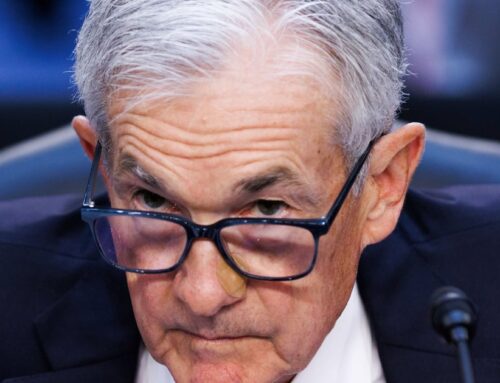How actively managed ETFs can help investors weather volatility
November 5, 2025
US stocks (^DJI, ^GSPC, ^IXIC) bounce back on Wednesday after Tuesday’s sell-off.
Clough Capital CEO and president Vince Lorusso joins Market Catalysts with Yahoo Finance Senior Reporter Allie Canal, highlighting that actively managed exchange-traded funds (ETFs), opposed to passively managed funds, could be a solution for investors weighing options to withstand market volatility.
To watch more expert insights and analysis on the latest market action, check out more Market Catalysts.
00:00 Ally
Well, the recent tech volatility may have some investors on edge, but our next guest is here to break down how you can stay exposed to tech through ETFs while keeping volatility in check. We’re joined by Vince LaRusso, Cloud Capital CEO and President for this week’s ETF report brought to you by Invesco QQQ. And Vince, it’s just been a roller coaster for tech investors, especially this past week. So given all the swings that we we’ve seen, how can ETFs help investors smooth out their exposure to tech a bit?
00:46 Vince LaRusso
Yeah, it’s been a bumpy ride, Ally, and thanks for having me. I think the, you know, the the general assumption about ETFs for so many years has been that they’re passive strategies, right? You have the benefits of liquidity, tax efficiency and transparency. But the really the the innovation that’s happening within ETF since the regulatory changes in 2019 have introduced a wide range of actively managed ETFs. And I think, you know, as an investor trying to get from point A to B, you know, navigating cycles and some of the volatility, you have a choice as whether you want to outsource that risk management to an active manager or whether you want to own that yourself within, you know, the allocation decisions that you make to often times passive strategies to, uh, get exposure to a sector or a geography or a benchmark. Um, and we happen to think, of course, at Cloud Capital, we’re fundamental active managers, and we think that this is a really good time in the market cycle to be leaning on active managers to help navigate some of that volatility.
02:00 Ally
Well, let’s talk a little bit more about passive versus active investing in the ETF space. What’s the main difference between the two for investors that don’t know and are looking to maybe diversify their exposure?
02:16 Vince LaRusso
Yeah, one of the interesting things I think Ally is that the ETF name and culture, I mean, really it just it tells you what the structure is, right? It tells you the chassis of the investment vehicle. In our case, the ETFs that I managed, CBLS and CBSE, are listed on the New York Stock Exchange. Many ETFs are exchange list listed, of course, by definition. That doesn’t really tell you anything about the investment strategy or the mandate. So investors really need to to read the prospectus, to to understand the investment process, to think about the investible universe. The primary difference as we think about it at Cloud Capital, gets back to that discussion about risk management. You know, do you want to have passive exposure to a benchmark or a sector or geography? Or do you want to hire an active manager to help navigate some of those choices, to apply their unique brand of research. In our case, it’s fundamental research, right? We think about where we are in the macro environment, what themes do we like, which specific securities do we want to get exposure to? and we construct our ETF through that process. There are thousands of ETFs of course, right? And the vast majority of those are still passive. And look, we think that’s a great way to get beta. Um anybody who’s making a sophisticated asset allocation model is likely going to have some passive exposure, probably using ETFs. And we start to think about, okay, where can you generate alpha? Where can you actually find an experienced asset manager who has an investment process that can help us generate returns above a benchmark over a period of time and hopefully do that with less volatility. And that’s really the nuance between at a very high level, I think that’s the big nuance between ETFs. Are they passive or are they active? And we’re seeing a huge surge of of actively managed ETFs because of some of those regulatory changes that have happened quite recently.
04:22 Ally
And let’s talk about some of the themes you like. I mean, it seems like it’s all tech, all the time right now, all AI. Are there other types of themes that your research team is focused on within this current environment?
04:39 Vince LaRusso
Yeah, Ally, we would concede that tech is the driving force between economic growth and market capitalization. I think it looks less like a bubble to us because so much of the free cash flow generation is also coming from technology. The productivity gains are coming from technology. So, you know, technology is really the underpinning of so much of the global economy and economic growth. It’s hard not to have exposure to tech. You know, we start to think about, okay, what are the derivative plays around technology? What are the specific places within the chain that you want to have exposure today. And that’s what gets really exciting from a fundamental bottom-up research perspective to say, look, we’re not we’re not just talking about semiconductor chips at this point. I mean, obviously that’s the the tip of the spear, that’s been the driver of the computational capability that’s it’s really been innovative and introducing a lot of, you know, capabilities across the consumer landscape, industrial, healthcare and beyond. Um, you get into the semiconductor fabs and manufacturers, the designers, and now we’re talking about the data centers, right? The build out of the infrastructure and how do we supply the energy that’s needed to produce all this compute. So, you know, it really gives you a wide range of exposure where you say, look, strictly from a a GIX or a sector basis, there’s some number of technology stocks, some percentage of market cap, but the ramifications are are extending so far beyond that that we can find, you know, biotech companies that are being impacted, media companies that are being impacted. It gives us, you know, the benefit of having a really wide broad mandate and going out and doing the fundamental bottom-up research, means we can get exposure to themes without having to to stick to a specific sector.
06:21 Ally
And given all those themes, given the broadening out of AI and all of those, uh, ramifications that you were just discussing, what’s your broad outlook for the rest of the year into 2026? How are you thinking about positioning with within the market and within a lot of these ETFs?
06:45 Vince LaRusso
Yeah, so I would say and I alluded to earlier, I see idea that from a from a firm perspective, what we try to do is identify the profit cycles and think about credit cycles and we really I think of that as the compass for our firm, right? We begin our research by saying, all right, where are we? And I think that’s the nature of your question. Where are we in the economic cycle? And where are we in the stock market, you know, evolution? and we land quite bullish for technological innovation being one of those reasons, but also demographics, right? We have a number of the baby boomer generation, they’re moving into retirement. We think that’s a deflationary pressure. We think they’re going to be passing on the housing stock that they’ve created over the decades to the next generation. So, you know, when you look at what’s happening with with interest rates, the frankly not a lot of appetite there for for credit spreads and bonds. We think equities are a great place for investors to be. So we start out saying we’re really bullish. I think if we move to that next phase of our process to say thematically, what do we like? It’s technology, it’s the infrastructure to build out some of the data centers and some of the media and biotech companies that are positioned to benefit. We like natural gas names. So it’s a it’s a pretty eclectic group. if you look at, you know, cloudETF.com, we list all of our holdings. And and what I tend to see for folks is the feedback tends to be, look at, you know, maybe a third of these names are household names, well-known, maybe a couple of, you know, the hyper scalers are in there and then maybe a third are less well-known and then a third are are kind of just, you know, off the grid a little bit. They’re small, they’re midcap stocks that we’ve identified and we like. So thematically, it’s a pretty broad group, it centers around technology and then the idiosyncratic. I mean, that’s really for us where where kind of the rubber hits the road, right? We do the bottom-up research, we meet with management teams, and we construct that portfolio of the highest conviction ideas.
08:29 Ally
All right, Vince, a lot to look forward to in the year ahead. Thank you so much.
08:35 Vince LaRusso
Thank you.
Terms and Privacy Policy
Search
RECENT PRESS RELEASES
Related Post




